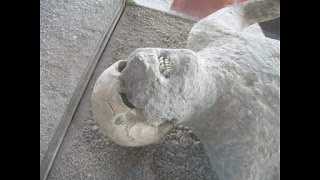The Ash Casts of Pompeii
The Ash Casts of Pompeii
Mount Vesuvius, a volcano near the Bay of Naples in Italy, has erupted more than 50 times. Its most famous eruption took place in the year 79 A.D., when the volcano buried the ancient Roman city of Pompeii under a thick carpet of volcanic ash. The dust “poured across the land” like a flood, one witness wrote, and shrouded the city in “a darkness…like the black of closed and unlighted rooms.” Two thousand people died, and the city was abandoned for almost as many years. When a group of explorers rediscovered the site in 1748, they were surprised to find that–underneath a thick layer of dust and debris–Pompeii was mostly intact. The buildings, artifacts and skeletons left behind in the buried city have taught us a great deal about everyday life in the ancient world.
The bodies of Pompeii had been covered in layers of fine ash that calcified over the centuries, forming a type of protective shell around their bodies. When the skin and tissue of these bodies eventually decayed, they left voids in the layer of ash around them in the exact shape of the victims in their final moments.










Comments
Post a Comment